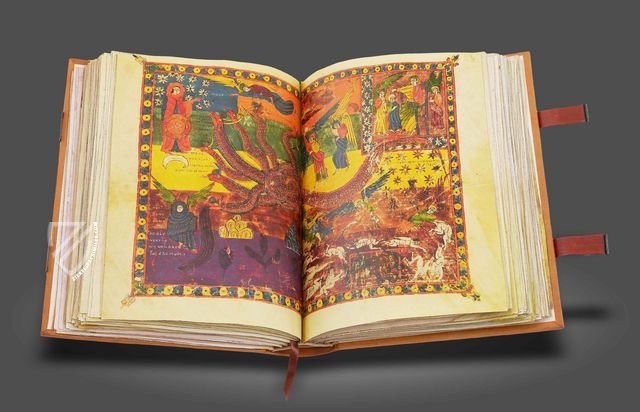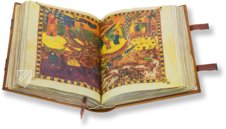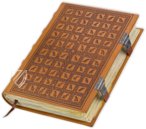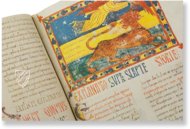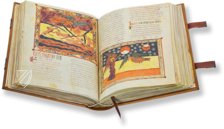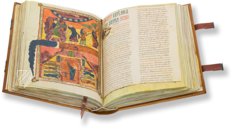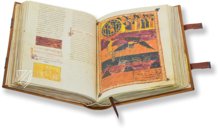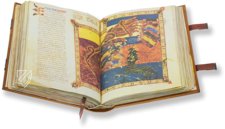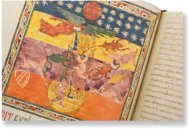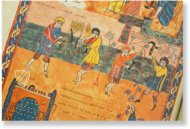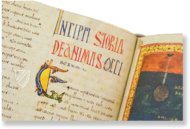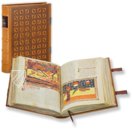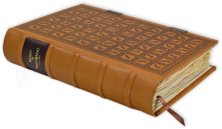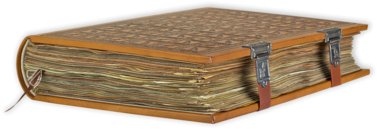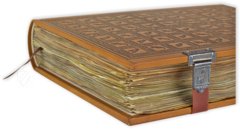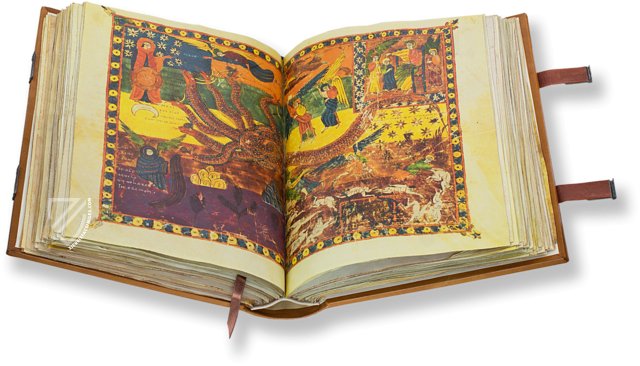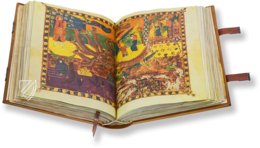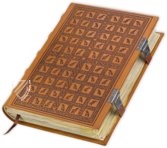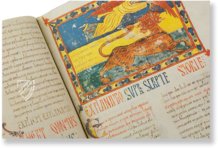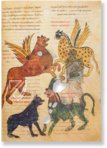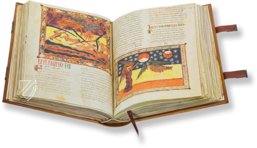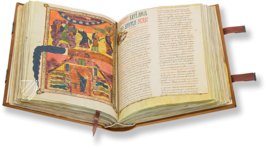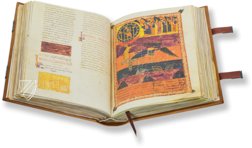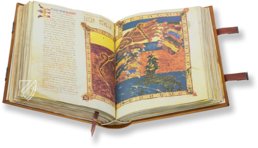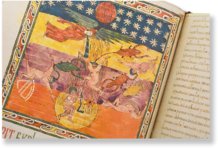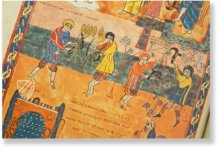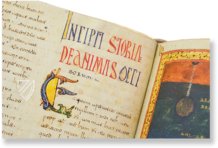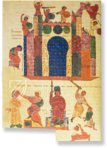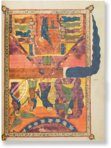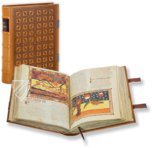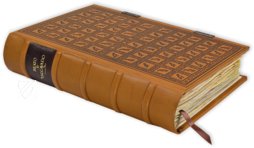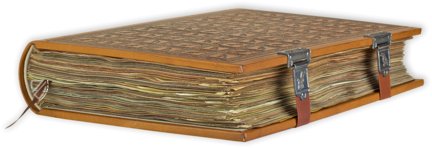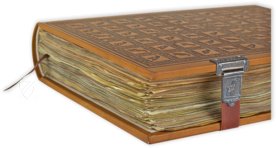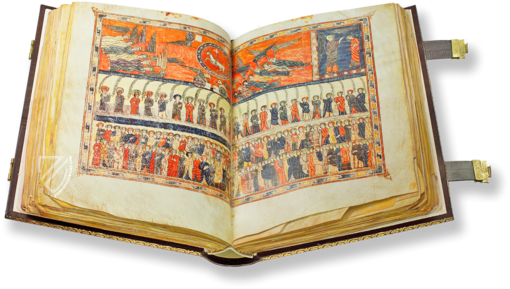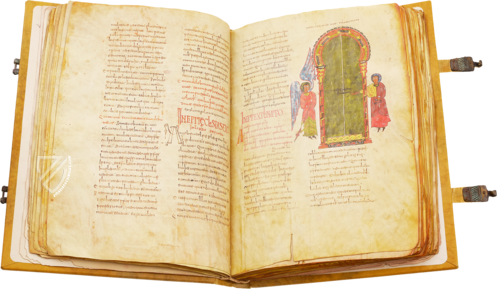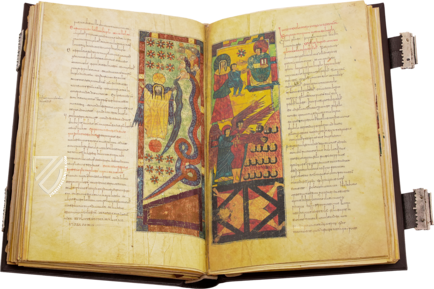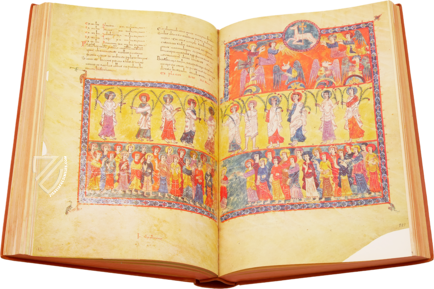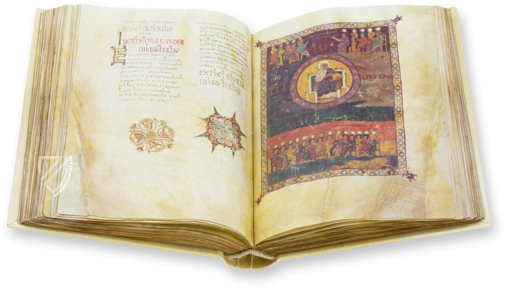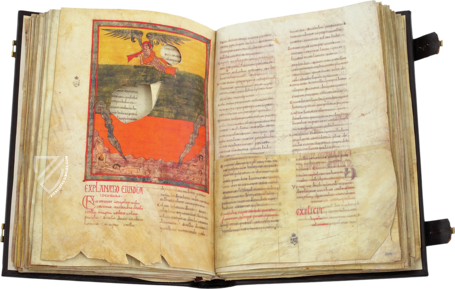Beatus of Liébana - Valcavado Codex
(3,000€ - 7,000€)
The Valcavado Beatus, also known as the Valladolid Beatus, is considered to be “one of the most impressive works of art from Spain”. Originating from the year 970, the manuscript is an impressive codex from the Monastery of Santa Maria in Valcavado, where it resurfaced during the 17th century. It is counted among the most important Spanish works of art and illustrates the famous commentary on the Book of Revelation by Beatus of Liébana with gorgeous miniatures, some of them spanning a double page, which have a distinct and unusual color palette. With that, the Valcavado Beatus stands firmly in the traditions of marvelous, large-format, richly illustrated Beatus Manuscripts of the 10th century. Also worthy of note in this marvelous specimen of the medieval Beatus tradition of northern Spain are the numerous pieces of evidence pointing to its patron, the artist who created it, and even the exact time of its creation.
Beatus of Liébana - Valcavado Codex
The Valcavoda Beatus, also known as the Valladolid Beatus, is considered to be “one of the most impressive works of art from Spain”. Originating from the year 970, the manuscript is an impressive work from the Monastery of Santa Maria in Valcavado. The famous commentary on the Book of Revelation by Beatus of Liébana is illustrated in gorgeous pictures. With that, the Valcavoda Beatus stands firmly in the traditions of marvelous, large-format, richly illustrated Beatus Manuscripts of the 10th century. Also worthy of note in this marvelous specimen of the medieval Beatus tradition of northern Spain are the numerous pieces of evidence pointing to its patron, the artist who created it, and even the exact time of its creation.
Straight through Spain
The Beatus of Liébana - Valcavado Codex is stored today in the collection of the historic library of the University of Valladolid, which is why it is also known as the Valladolid Beatus. The term Valcavado Codex comes from its place of origin, the Monastery of Santa Maria in Valcavado in northern Spain. It was stored in the church there until the 16th century. The manuscript came to Madrid through a secretary of Philip II. The Valcavoda Beatus finally resurfaced in Valladolid in the 17th century. There it is stored to this day, over 1,000 years after its creation, and counts among the most important Spanish works of art!
An Impressive Masterwork
An interesting indication of the origins of the Beatus is found on the third page of the manuscript. It is recorded there that the work on the manuscript lasted exactly from June 8th to Spetember 8th, 970. The work was commissioned by Abbot Sempronius of Santa Maria in Valcavado. A certain Obeco was the miniaturist and scribe who executed the work. The manuscript’s 460 pages are adorned with 97 magnificent miniatures. These sometimes double-paged depictions are characterized by an impressive style, which manifests itself in the gorgeous, large almond eyes of the figure, for example. The numerous marginal notes and references in the text, which either come from the scribe himself or were added later, are remarkable. Altogether, the codex, which was stored at is place of origin until the 16th century, is in extremely good condition.
The Famous Apocalypse Commentary
The foundation of this splendid piece of illumination is the magnum opus of Beatus of Liébana (d. 798): the commentary on the Book of Revelation in twelve books. This groundbreaking work, originating from shortly before 800, offered illuminators and miniaturists the opportunity to test innovative visual inventions away from the common iconography of biblical tales. The biblical text of John’s revelation about the end of the world, with its numerous fantastical, mysterious, and hard to interpret symbolic pictures has not lost any of its fascination today. Nonetheless it needed a detailed explanation, which Beatus of Liébana delivered with his commentary. The 30+ known manuscripts of this commentary, all of them masterpieces of northern Spanish illumination in the Middle Ages, bear witness to the fact that the Apocalypse inspired artists to true flights of fancy. The Valcavado Codex is one of these magnificent attestations of such fantastic art!
Codicology
- Alternative Titles
- Beatus von Liébana - Codex Valcavado
Valladolid Beatus
Beato Valcavado
Valcavado Beatus - Size / Format
- 460 pages / 35.5 × 24.5 cm
- Origin
- Spain
- Date
- June 8 to September 8, 970
- Epochs
- Style
- Genre
- Language
- Illustrations
- 97 miniatures, some on two pages and a large number on whole pages
- Patron
- Abbot Sempronius
- Artist / School
- Beatus of Liébana (died after 798) (author)
Oveco (scribe and illuminator) - Previous Owners
- St. Ambrose College
Beatus of Liébana - Valcavado Codex
The Four Beasts of Daniel
Daniel was a visionary among the young Hebrews taken into the Babylonian Captivity. Many of his dreams concerned the “four kingdoms” – a prophecy of four empires that would rule over the earth before the Kingdom of God was established. In one of these dreams, he sees four beasts: a lion with eagle’s wings, a bear with three ribs in its teeth, a leopard with four bird’s wings, and a fourth beast unlike the others with iron teeth and ten horns, one with the face of a man speaking pompous words.
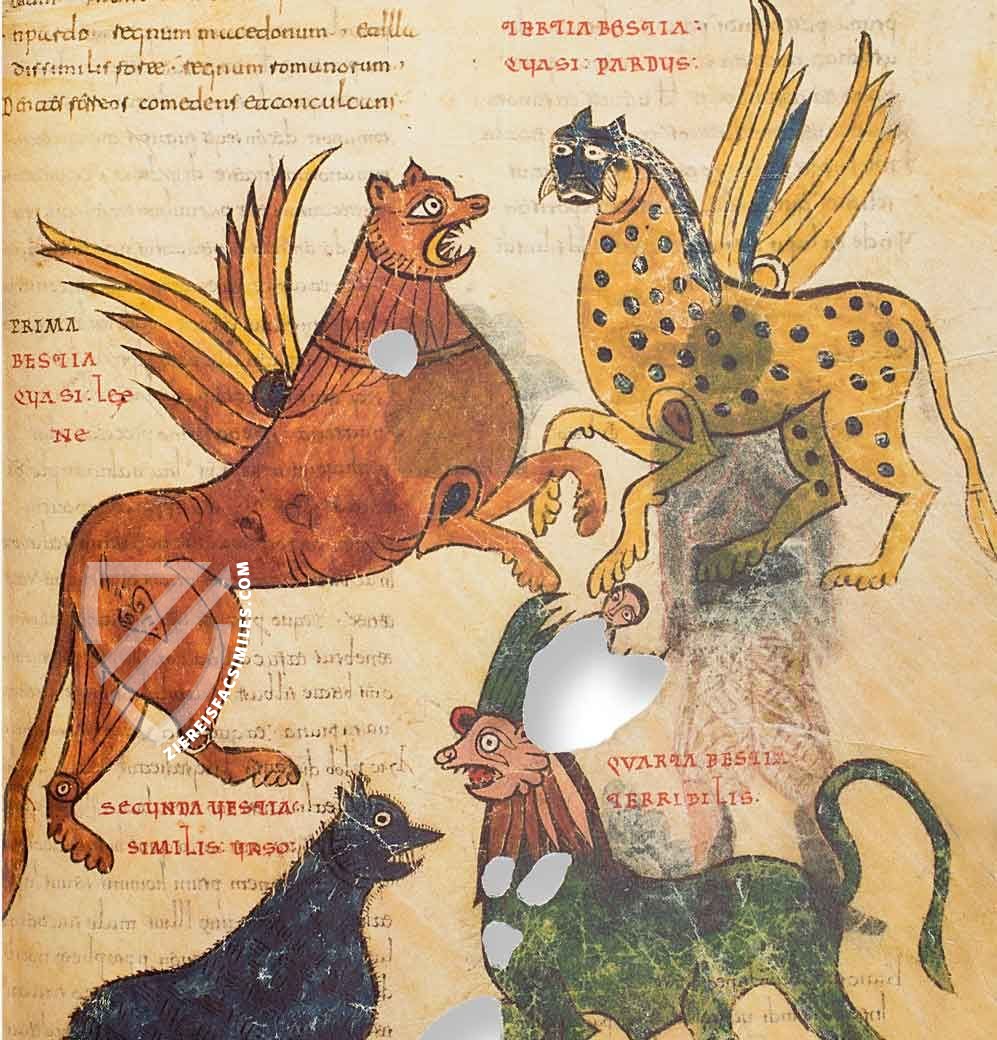
Beatus of Liébana - Valcavado Codex
Siege of Jerusalem
St. John’s Revelation is firmly rooted in the prophetic and apocalyptic texts of the Old Testament, which often revolved around Jerusalem’s destruction or the threat thereof. This scene is called the Siege of Jerusalem, the final battle in the Book of Revelation when Satan is finally defeated.
The Mozarabic influence in the miniature is immediately recognizable in the city’s gate, which takes the form of a Moorish- or horseshoe arch. Scenes of carnage surround the architecture and two seated figures, one to the left of the gate is lamenting while the other, holding a spear, is identified as a general. The missing lower-left corner begs the question, was it cut out by censors in a later century, or did someone simply need to write a note?
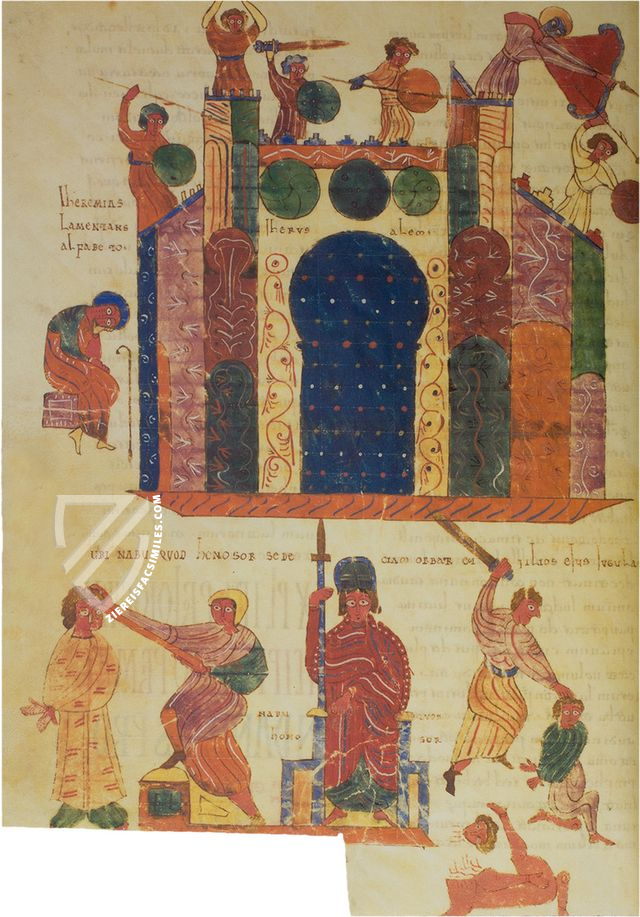
#1 Beato de Valcavado Beatus of Liébana - Valladolid Codex
Language: Spanish
(3,000€ - 7,000€)
- Treatises / Secular Books
- Apocalypses / Beatus
- Astronomy / Astrology
- Bestiaries
- Bibles / Gospels
- Chronicles / History / Law
- Geography / Maps
- Saints' Lives
- Islam / Oriental
- Judaism / Hebrew
- Single Leaf Collections
- Leonardo da Vinci
- Literature / Poetry
- Liturgical Manuscripts
- Medicine / Botany / Alchemy
- Music
- Mythology / Prophecies
- Psalters
- Other Religious Books
- Games / Hunting
- Private Devotion Books
- Other Genres
- Afghanistan
- Armenia
- Austria
- Belgium
- Belize
- Bosnia and Herzegovina
- China
- Colombia
- Costa Rica
- Croatia
- Cyprus
- Czech Republic
- Denmark
- Egypt
- El Salvador
- Ethiopia
- France
- Germany
- Greece
- Guatemala
- Honduras
- Hungary
- India
- Iran
- Iraq
- Israel
- Italy
- Japan
- Jordan
- Kazakhstan
- Kyrgyzstan
- Lebanon
- Liechtenstein
- Luxembourg
- Mexico
- Morocco
- Netherlands
- Palestine
- Panama
- Peru
- Poland
- Portugal
- Romania
- Russia
- Serbia
- Spain
- Sri Lanka
- Sweden
- Switzerland
- Syria
- Tajikistan
- Turkey
- Turkmenistan
- Ukraine
- United Kingdom
- United States
- Uzbekistan
- Vatican City
- A. Oosthoek, van Holkema & Warendorf
- Aboca Museum
- Ajuntament de Valencia
- Akademie Verlag
- Akademische Druck- u. Verlagsanstalt (ADEVA)
- Aldo Ausilio Editore - Bottega d’Erasmo
- Alecto Historical Editions
- Alkuin Verlag
- Almqvist & Wiksell
- Amilcare Pizzi
- Andreas & Andreas Verlagsbuchhandlung
- Archa 90
- Archiv Verlag
- Archivi Edizioni
- Arnold Verlag
- ARS
- Ars Magna
- ArtCodex
- AyN Ediciones
- Azimuth Editions
- Badenia Verlag
- Bärenreiter-Verlag
- Belser Verlag
- Belser Verlag / WK Wertkontor
- Benziger Verlag
- Bernardinum Wydawnictwo
- BiblioGemma
- Biblioteca Apostolica Vaticana (Vaticanstadt, Vaticanstadt)
- Bibliotheca Palatina Faksimile Verlag
- Bibliotheca Rara
- Boydell & Brewer
- Bramante Edizioni
- Bredius Genootschap
- Brepols Publishers
- British Library
- C. Weckesser
- Caixa Catalunya
- Canesi
- CAPSA, Ars Scriptoria
- Caratzas Brothers, Publishers
- Carus Verlag
- Casamassima Libri
- Centrum Cartographie Verlag GmbH
- Chavane Verlag
- Christian Brandstätter Verlag
- Circulo Cientifico
- Club Bibliófilo Versol
- Club du Livre
- CM Editores
- Collegium Graphicum
- Collezione Apocrifa Da Vinci
- Comissão Nacional para as Comemorações dos Descobrimentos Portugueses
- Coron Verlag
- Corvina
- CTHS
- D. S. Brewer
- Damon
- De Agostini/UTET
- De Nederlandsche Boekhandel
- De Schutter
- Deuschle & Stemmle
- Deutscher Verlag für Kunstwissenschaft
- DIAMM
- Droz
- E. Schreiber Graphische Kunstanstalten
- Ediciones Boreal
- Ediciones Grial
- Ediclube
- Edições Inapa
- Edilan
- Editalia
- Edition Deuschle
- Edition Georg Popp
- Edition Leipzig
- Edition Libri Illustri
- Editiones Reales Sitios S. L.
- Éditions de l'Oiseau Lyre
- Editions Medicina Rara
- Editorial Casariego
- Editorial Mintzoa
- Editrice Antenore
- Editrice Velar
- Edizioni Edison
- Egeria, S.L.
- Eikon Editores
- Electa
- Emery Walker Limited
- Enciclopèdia Catalana
- Eos-Verlag
- Ephesus Publishing
- Ernst Battenberg
- Eugrammia Press
- Extraordinary Editions
- Fackelverlag
- Facsimila Art & Edition
- Facsimile Editions Ltd.
- Facsimilia Art & Edition Ebert KG
- Faksimile Verlag
- Feuermann Verlag
- Folger Shakespeare Library
- Franco Cosimo Panini Editore
- Friedrich Wittig Verlag
- Fundación Hullera Vasco-Leonesa
- G. Braziller
- Gabriele Mazzotta Editore
- Gebr. Mann Verlag
- Gesellschaft für graphische Industrie
- Getty Research Institute
- Giovanni Domenico de Rossi
- Giunti Editore
- Graffiti
- Grafica European Center of Fine Arts
- Guido Pressler
- Guillermo Blazquez
- Gustav Kiepenheuer
- H. N. Abrams
- Harrassowitz
- Harvard University Press
- Helikon
- Hendrickson Publishers
- Henning Oppermann
- Herder Verlag
- Hes & De Graaf Publishers
- Hoepli
- Holbein-Verlag
- Houghton Library
- Hugo Schmidt Verlag
- Idion Verlag
- Il Bulino, edizioni d'arte
- ILte
- Imago
- Insel Verlag
- Insel-Verlag Anton Kippenberger
- Instituto de Estudios Altoaragoneses
- Instituto Nacional de Antropología e Historia
- Introligatornia Budnik Jerzy
- Istituto dell'Enciclopedia Italiana - Treccani
- Istituto Ellenico di Studi Bizantini e Postbizantini
- Istituto Geografico De Agostini
- Istituto Poligrafico e Zecca dello Stato
- Italarte Art Establishments
- Jan Thorbecke Verlag
- Johnson Reprint Corporation
- Josef Stocker
- Josef Stocker-Schmid
- Jugoslavija
- Karl W. Hiersemann
- Kasper Straube
- Kaydeda Ediciones
- Kindler Verlag / Coron Verlag
- Kodansha International Ltd.
- Konrad Kölbl Verlag
- Kurt Wolff Verlag
- La Liberia dello Stato
- La Linea Editrice
- La Meta Editore
- Lambert Schneider
- Landeskreditbank Baden-Württemberg
- Leo S. Olschki
- Les Incunables
- Liber Artis
- Library of Congress
- Libreria Musicale Italiana
- Lichtdruck
- Lito Immagine Editore
- Lumen Artis
- Lund Humphries
- M. Moleiro Editor
- Maison des Sciences de l'homme et de la société de Poitiers
- Manuscriptum
- Martinus Nijhoff
- Maruzen-Yushodo Co. Ltd.
- MASA
- Massada Publishers
- McGraw-Hill
- Metropolitan Museum of Art
- Militos
- Millennium Liber
- Müller & Schindler
- Nahar - Stavit
- Nahar and Steimatzky
- National Library of Wales
- Neri Pozza
- Nova Charta
- Oceanum Verlag
- Odeon
- Orbis Mediaevalis
- Orbis Pictus
- Österreichische Staatsdruckerei
- Oxford University Press
- Pageant Books
- Parzellers Buchverlag
- Patrimonio Ediciones
- Pattloch Verlag
- PIAF
- Pieper Verlag
- Plon-Nourrit et cie
- Poligrafiche Bolis
- Presses Universitaires de Strasbourg
- Prestel Verlag
- Princeton University Press
- Prisma Verlag
- Priuli & Verlucca, editori
- Pro Sport Verlag
- Propyläen Verlag
- Pytheas Books
- Quaternio Verlag Luzern
- Reales Sitios
- Recht-Verlag
- Reichert Verlag
- Reichsdruckerei
- Reprint Verlag
- Riehn & Reusch
- Roberto Vattori Editore
- Rosenkilde and Bagger
- Roxburghe Club
- Salerno Editrice
- Saltellus Press
- Sandoz
- Sarajevo Svjetlost
- Schöck ArtPrint Kft.
- Schulsinger Brothers
- Scolar Press
- Scrinium
- Scripta Maneant
- Scriptorium
- Shazar
- Siloé, arte y bibliofilia
- SISMEL - Edizioni del Galluzzo
- Sociedad Mexicana de Antropología
- Société des Bibliophiles & Iconophiles de Belgique
- Soncin Publishing
- Sorli Ediciones
- Stainer and Bell
- Studer
- Styria Verlag
- Sumptibus Pragopress
- Szegedi Tudomànyegyetem
- Taberna Libraria
- Tarshish Books
- Taschen
- Tempus Libri
- Testimonio Compañía Editorial
- Thames and Hudson
- The Clear Vue Publishing Partnership Limited
- The Facsimile Codex
- The Folio Society
- The Marquess of Normanby
- The Richard III and Yorkist History Trust
- Tip.Le.Co
- TouchArt
- TREC Publishing House
- TRI Publishing Co.
- Trident Editore
- Tuliba Collection
- Typis Regiae Officinae Polygraphicae
- Union Verlag Berlin
- Universidad de Granada
- University of California Press
- University of Chicago Press
- Urs Graf
- Vallecchi
- Van Wijnen
- VCH, Acta Humaniora
- VDI Verlag
- VEB Deutscher Verlag für Musik
- Verlag Anton Pustet / Andreas Verlag
- Verlag Bibliophile Drucke Josef Stocker
- Verlag der Münchner Drucke
- Verlag für Regionalgeschichte
- Verlag Styria
- Vicent Garcia Editores
- W. Turnowski Ltd.
- W. Turnowsky
- Waanders Printers
- Wiener Mechitharisten-Congregation (Wien, Österreich)
- Wissenschaftliche Buchgesellschaft
- Wissenschaftliche Verlagsgesellschaft
- Wydawnictwo Dolnoslaskie
- Xuntanza Editorial
- Zakład Narodowy
- Zollikofer AG

